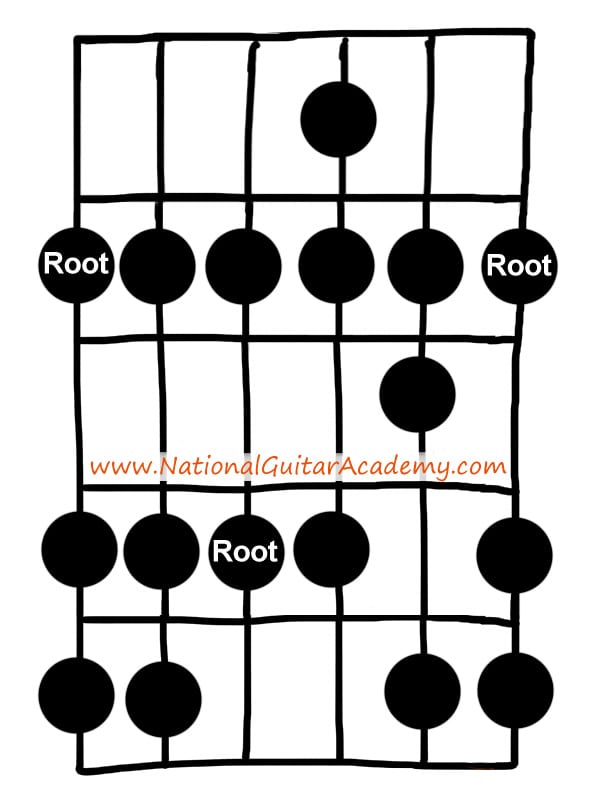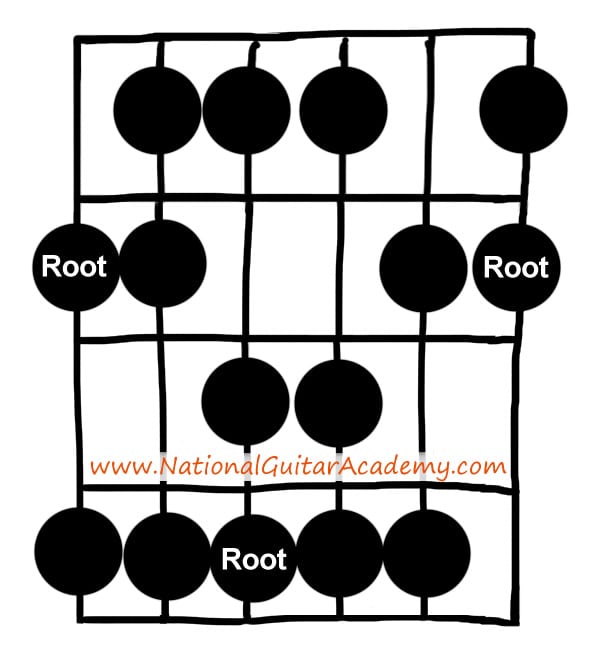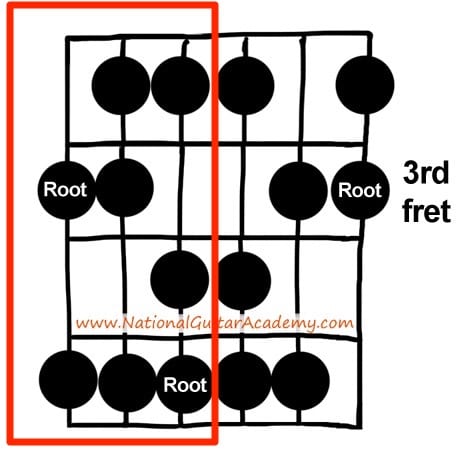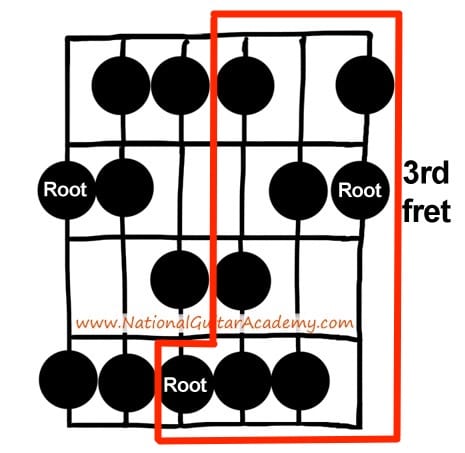.
Classical guitar lessons 3) The Natural minor scale
Okay, so far we’ve looked at chords and fingerpicking and now I’d like us to look at some melodic single-note techniques.
This is one of the best classical guitar lessons of all. I love this scale! The natural minor scale might be the coolest classical guitar scale of all, it just sounds so lovely. I could play this scale all day…..
.
In its full form the natural minor scale looks like this:
If you don’t understand this diagram read this article.
Like most guitar scales, this is a moveable pattern.
This means that you can play this scale pattern anywhere on the neck and it will always be the natural minor scale.
What dictates the tonality of the scale is where you begin playing it.
- If you begin playing the scale on the 5th fret you will be playing the A natural minor scale.
- If you begin playing the scale on the 7th fret you will be playing the B natural minor scale.
- And so on…
To learn a lot more about the notes of the fret board and the musical alphabet read this article Guitar Notes Explained: A Guide For Beginners
When you learn this scale it’s best to learn it in two halves. Learn the notes on strings 6, 5 and 4 first. Then when you have that pattern memorised you can learn the notes on strings 3, 2 and 1.
This is one of the essential classical guitar lessons, you really must know this scale.
How to learn this scale
As with all scales it’s best to learn slowly and correctly to embed solid muscle memory that gives you a great foundation for the future.
Don’t fall into the trap that most beginners do of playing the scale as quickly as possible. This leads to lots of mistakes and flaky muscle memory.
.
.
Classical Guitar Lessons 4) The Major Scale
This is the foundation for all music theory and is another one of those classical guitar lessons that you can file under ‘essential knowledge’. To be honest, this is a must-know for any guitarist, but for a classical guitarist it’s even more important.
In its full form the major scale looks like this:
This is a bright and happy-sounding scale that has an optimism about it which I love and never grow tired of.
The A Major Scale sounds like this:
.
It’s important to understand that this is a two octave pattern. Octave one is the first half. (Learn this first.)
Let’s look at this with the G Major Scale:
Octave two is the second half. Note that it begins on the SAME NOTE that octave 1 ended on:
Again this is a movable scale pattern which means this is one those classical guitar lessons you can apply again and again in almost any situation.
- If you start playing this scale pattern on the 3rd fret you will be playing the G major scale.
- If you start playing this scale pattern on the 5th fret you will be playing the A major scale.
- And on the 7th fret you will be playing the B major scale and so on.
How to use these to scales
There are literally thousands of ways you can integrate these scales into your guitar playing.
But perhaps the most practical thing to consider is how you can blend these with chords and how you could use the scales to accompany other musicians.
.
How to jam with the scales
Let’s say you are playing with another guitarist and they are playing a simple chord progression like C to Am.
If you wanted to play along with them you could play the same chords, that would sound okay, but a little bland because you’d both be playing the exact same thing!
It would be far more interesting and nuanced and musical and expressive if you played some melodic lead lines to complement the chords that your friend was playing.
.
But of course the question is how do I know what notes will work?
- It’s very simple! If your friend is playing a C chord then you can play any note from the C major scale and it will sound great. (Some notes will sound better than others but none will sound ‘bad’.)
- If your friend is playing Am then you can play any note from the A natural minor scale and it will sound great.
And of course these rules apply for all chords.
Blending chords and melodic single-note lines
As you improve as a guitarist you will be able to blend chords and melodic lines together yourself, on-the-fly.
So for example you may be changing chords from C to G and during the transition you might spice things up with a few notes from the C major scale. ‘Switching’ between chords/strumming and melodic single notes is a fabulous way to make your guitar playing sound more intelligent and textured.
But of course it will take time to get comfortable with all this!
Start off learning some simple chord shapes and then go from there. I hope you’ve enjoyed these four steps and that they’ve given you a useful roadmap that you can follow as you move forward and become a better classical guitarist. It’s an exciting journey and I’m so thrilled for you. You’re in for a treat!
What Type of Guitarist Are You?
Take our 60-second quiz & get your results: Take The Quiz
Join the world's best online guitar school 🌎
- Get your own personalised guitar learning plan (customised just for YOU).
- World-class online guitar courses. Learn at your own pace.
- Community Campus & Learning Forum - A friendly community! Connect with our team & students. 😊
- Beginner Song library with chordsheets, tabs and tips. (Songs suitable for all levels!)
- Regular live streams, seminars and Q&A sessions - Learn from world-class guitar educators. Get all your questions answered!
Click here to learn more about National Guitar Academy membership 
Cool Guitar T-shirts 😎
Look cooler! Check out our merch: Click here to see our merch store
Want free guitar tips and video lessons delivered to your inbox?
Join over 250,000 other guitar learners and subscribe to our guitar-tips-by-email service. (It's free.)
We'll send you a series of lessons that will move you to the next level of your guitar journey.
Learn how everything fits together quickly, easily and effectively. We share ninja tips (for instant fun!) but also timeless fundamentals that will deepen your understanding.

Popular Lessons
How To Learn Guitar: An 11-Step Programme For Beginners
How To Choose The Perfect Beginner Guitar
More Cool Guitar Stuff
Learn about National Guitar Academy: About Us
Visit our YouTube channel for fun guitar videos.
Join us on Facebook for daily guitar tips.
Listen to our Learn Guitar Podcast for rapid guitar progress.
Check out our free chord lessons.
Get our best guitar tips & videos









